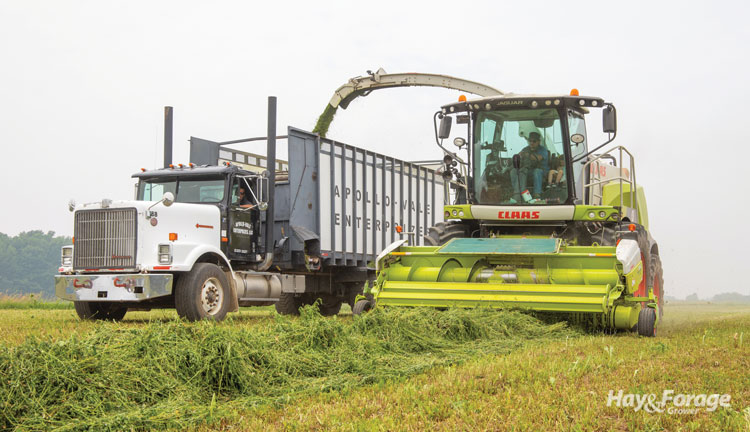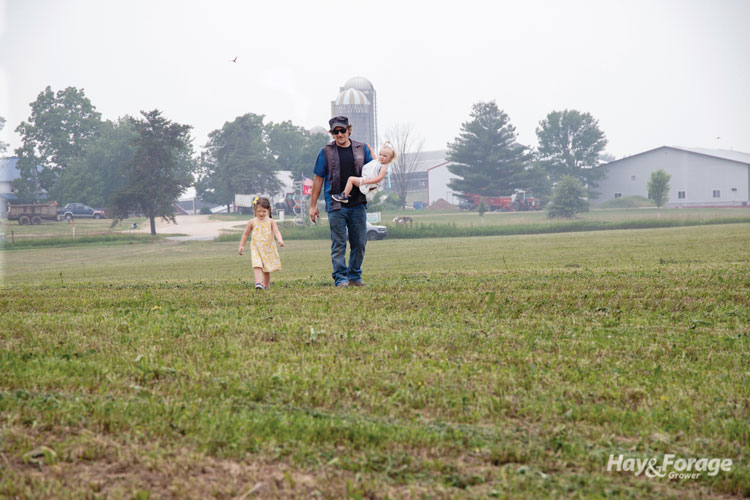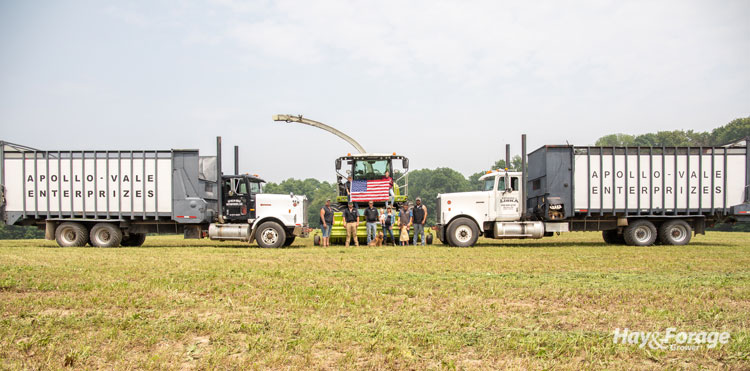
The hills of Wisconsin’s Driftless Region were masked in a smoky haze from wildfires burning much farther north. Earlier that morning, it had rained. It wasn’t the best of hay drying days. Even so, by late morning, Ray called and said it was a “go.”
On this particular afternoon, 38-year-old Ray Liska was chopping alfalfa for Ocooch Dairy near Hillsboro, Wis. Chopping forage runs in the sixth-generation farmer’s blood. Between planting and harvesting their own crops, producing broiler chickens, and raising a family, Ray and his wife, Holly, own and operate a successful custom forage harvesting business called Apollo-Vale Enterprizes.
Liska grew up on a small Wisconsin dairy farm, also near Hillsboro, but he was more interested in machinery than his father’s show cows. “When I was still young, my father suffered a stroke that resulted in right-side sight damage,” Ray recalled. “I started doing the harvesting with our pull-type chopper when I was about 12 years old because it was easier for me to look back at the header.”
Following high school, Liska attended technical college to study diesel and heavy equipment mechanics. One day while driving a dump truck during the summer, he noticed a self-propelled chopper in the field and decided that was what he wanted to do. In 2006, Liska bought his first truck and began hauling silage. He purchased a Miller Pro hay merger one year later and bought his first self-propelled chopper in 2010, which eventually caught on fire but not before logging 6,500 hours.
“Ray is passionate about chopping,” asserted Holly, a fourth-generation farmer who was also raised on a dairy farm. “Ray is jealous when someone else is out in the field and he isn’t. We can be in the middle of a deep conversation, and if Ray sees a silage truck on the road, I know the conversation is over. He will want to go and see where the action is taking place. ”
A well-oiled system
These days, Apollo-Vale Enterprizes is a full-service custom harvesting business that offers forage cutting, merging, chopping, trucking, and packing services. Harvesting alfalfa and corn silage comprise the large bulk of their business.
The business employs two full-time and three or four part-time workers, but additional help is also available during busy times such as corn silage harvest. “Labor has been a massive issue industry-wide, but we’ve been lucky and have always been able to find good employees locally,” Ray said.
Safety education has been one of Liska’s top priorities. He is heavily involved in the Wisconsin Custom Operators organization and their safety training program. All of his employees receive routine safety education,
When it’s time to hit the fields, alfalfa is mowed with a Claas triple mower. Swaths are brought together with two Oxbo mergers and chopped with a Claas Jaguar 970, which is equipped with a shredlage processor for corn silage.
“It’s definitely worth having two mergers on days when the hay is drying fast,” Ray explained. “My mower doesn’t have conditioning rolls, which saves fuel, offers less maintenance, and maneuvers easier. The downside is that the hay doesn’t always dry as fast in less than ideal conditions.” He also mentioned that the cut hay lays out in the same direction without conditioning rolls, so he typically will merge at a slight angle to the way it was cut, which aids in picking the crop up off the ground.
With only one chopper, Liska can’t afford too many breakdowns. “If the chopper goes down for some reason, I have a pretty good gentlemen’s agreement with other harvesters in the area, and we will cover for each other,” the former president of the Wisconsin Custom Operators said. “I have rarely needed to call on someone else, but it’s good to know they’re available. It’s about 40 miles to our nearest dealer, so we do all of our maintenance and repairs in-house and try to keep parts in stock.
“I’ve never been married to new iron, but I do like to invest in the latest technology, which is sometimes only available on newer machines. Overall, though, our philosophy is to make a piece of machinery last by taking care of it,” he added.
Liska also prioritizes taking care of his clients’ fields. All of the hauling units are equipped with flotation tires to minimize compaction and plant damage. His fleet includes four straight trucks; two forage boxes, which are used when conditions are excessively wet; and one semitractor-trailer. “There’s definitely evidence that the large-footprint tires make a difference even though they cost more and wear faster,” Ray asserted.
Working harder and smarter
Liska services both dairy and beef operations. He likes to stay within a 25-mile radius but will go farther for the right job. The business has about a half dozen core farms that they harvest for every year, and then they will pick up additional farms as time allows.
Being in the Driftless Region, Liska said that you have to work harder to get feed harvested, as many fields are small with significant slope. “It helps that I’ve grown up here my whole life and I don’t know much different. It makes harvesting more expensive with the smaller, odd-shaped fields, but we are also diverse enough that there are rarely complete crop failures.”
 Ray Liska makes his way to the chopper with daughters Mahala and Rayabelle.
Ray Liska makes his way to the chopper with daughters Mahala and Rayabelle.
Liska sees a push for higher forage diets on farms. “This makes timeliness of harvest really important, but the windows are narrow. Sometimes it’s too early to cut in the morning and by early afternoon, it’s too late,” he joked.
When Liska shows up to cut for his customers depends on the individual farm. In some cases, he might be the one to make the call of when to start. For others, they want the hay knocked down every 28 days, regardless of growth stage.
For corn silage, Liska encourages the farm’s nutritionist to be on site to check the particle length and kernel processing early in the harvest process. This occurs even though he checks the feed daily himself. Liska said that he never has a kernel processing score below 80. “My feeling is that the nutritionist is the one who will work with the feed and scrutinize my work, so I want them there. I want to have a relationship with the nutritionist. I learned this the hard way years ago when a nutritionist called me three or four months after harvest to complain about some aspect of the corn silage, and, by then, it was too late to do anything about it.”
By the hour
Out of the harvest season, Liska keeps in communication with his customers regarding next season’s plans. The analytical custom operator also is interested in evaluating the job that was done the previous season in terms of forage quality, yields, and packing densities. From this information, he tries to improve the next year.
Liska charges his clients by the hour for each machine and truck, but there are different rates for hay crops and corn silage. “I’ve looked at using a per ton or per acre metric, but in such a diverse area with smaller fields, it would be difficult to charge that way,” he said. “Our efficiencies can change dramatically within a few hours. That said, in the future, we may be able to incorporate an efficiency bonus whereby if we do better, then we can get paid more,” he noted.
“It has to be a symbiotic relationship between the farmer and us,” Holly added. “Depending on the customer, we only have so much control on the decisions that can be made. Ray is very much a data-driven guy, and he’s always trying to figure out a better way for both us and the farmer. But there are some customers who want to call all of the shots, so we can’t always control the forage quality or yield outcomes in those situations.”

Beyond custom work
Although running a custom harvesting business entails many long days during the growing season, Ray and Holly still find themselves with many other activities on their plates. They own several hundred acres of farmland near their home in Hillsboro where corn for silage, soybeans, and alfalfa is grown. This is land that the Liskas purchased from Ray’s parents.
Liska sells his corn silage that is wrapped with an Orkel Dens-X compactor and sold as compacted silage bales. “It’s excellent quality feed that usually sells to smaller dairy and beef producers who are just looking to supplement corn silage with what they are already feeding. We make 500 to 600 corn silage bales per year,” he noted. The alfalfa is either baled as dry hay or wrapped as baleage and then marketed. Since 2009, the Liskas also operate the family farm on his mother’s side in Cochrane, Wis., which is about two hours northwest of their home. There, they have two commercial chicken barns and grow 165 acres of corn and soybeans.
Ray and Holly, who were married in 2018 and share a strong Christian faith, have four children with a fifth due to be born shortly. Holly remains actively involved in the custom business by either working in the field or with business and employee management. She also homeschools their children.
To keep their business viable, both Ray and Holly are strong activists for regulation reform in the state. Holly has testified in front of the state legislature for issues such as getting the length of a farm service commercial driver’s license (CDL) extended to 210 days to better accommodate the length of the harvest season. Such a change would match the federal regulation. The Liskas are also concerned about other regulations that impact agriculture, such as those that define agricultural equipment and overreaching climate change policies that add to the cost of operating. “We feel burdened to ensure that our children have a good future in life and agriculture if they want it,” Holly said of her passion for regulation bird dogging.
Although Ray has a degree from the technical college, he attributes most of his success to the mentors he has had in his life. That includes his dad, other local farmers, and the relationships he has forged by being a member of the Wisconsin Custom Operators organization.
As for future plans, the Liskas are satisfied with looking for opportunities. “If the kids want to get involved someday, maybe their outlook will be different,” Holly surmised. “Both our 12-year-old boy and 14-year-old daughter are already involved in helping where they can, including the operation of equipment. If that interest continues into their young adult years, we’d like for them to work for someone else before they come back here permanently, though.”
Added Ray, “We, like every other farmer, are always looking for better ways to do things, improve efficiency, and make money. I always joke that someday the merger and chopper will be one machine.” In the meantime, the Liskas are just happy for the freedom to work and worship side by side as a family.
This article appeared in the August/September 2023 issue of Hay & Forage Grower on pages 6-8.
Not a subscriber? Click to get the print magazine.

